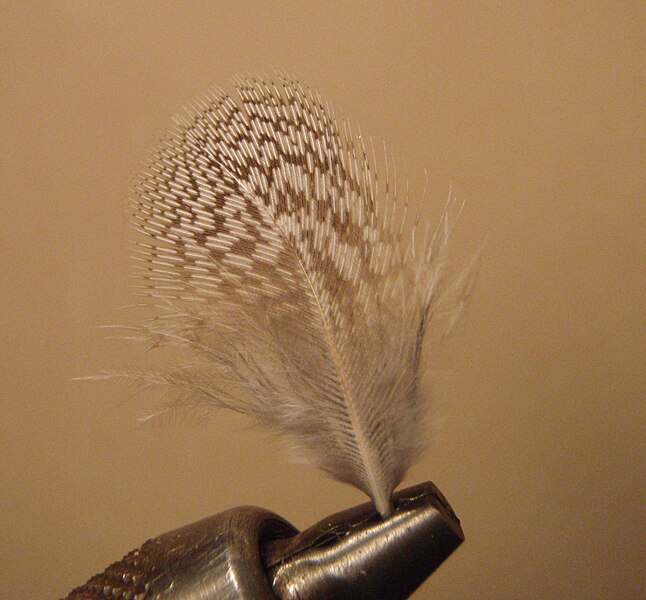Image at left from Mike Cline hosted on wikicommons and provided here copyright-free in the public domain. Nice photograph and thanks for the use here, Mike!
Time for the serious seasonal fly tying. It's a late start for me.
I've been "playing" with patterns here in the last couple months which is to say I've been chasing flags of whimsy.
I'm solidly in the presentationist school. While I've been playing with wonderful flies on the vise, I'm using a limited flybox this year to force my perfection of the "invisible presentation."
That's not a new cast.
The invisible presentation is a combination of a delivery competency that won't put a fish down upon landing, an approach that limits the spook-factor of the angler silhouette and movement within the trout's field of vision, and a mastery of the drift that presents the fly as living insect (nothing living drifts far "dead" or absent any natural movement ... debris dead-drifts) without encountering the betraying drag.
Chasing the magic fly at the vise will not aid in my pursuit.
I'll list my six flies for the year here on the blog and then do some demonstration ties to feature in the coming posts.
(1) The CDC Caddis.
It's Michigan. We're a caddis-heavy state and surface takes are fun. There are too many evening opportunities to entice active trout with a nice caddis to eliminate this fly from the arsenal. I'll tie them with coastal deer hair in light tan and brown. I've both skins and they're quite nice.
(2) (X) and Herl.
I'll use a nice speckled hen, a dun hen, starling, a partridge (of course), and a nice flat-black hen whose hackles are especially soft. I'll use these weighted and unweighted. Early on, I'll tie a few with tungsten beads.
I can tie then down to size 20 and adding a drop of floatant covers the midge hatch.
The X and Herl covers all levels of the water column. Tied Stewart-style as the ancient spiders and weighted, they make excellent isonychia at size 10 on the swing across the cobble and gravel.
(3) Partridge and Yellow.
I'll use Pearsall's silk on this traditional north country spider. It's a perfect "not-dark" mayfly here in my part of the world and is a reliable search pattern when I see no rising trout. It also feels good fishing something relatively pure that I've not adulterated in any way from a standard.
I'll tie some with a tight herl collar this year.
(4) The Purple and (X).
This is a new entry into my standard list this year.
I've got some lovely iridescent purple floss from Danville. I'll tie hackle using starling, speckled hen, and dun hen. I'll use the wire-wrapped and weighted as my "dark" deep flymph and in an unweighted variant for the early season emergers which tend to be darker around here.
I've read that the Purple and Snipe is an early season killer in the U.K. and I plan on testing it here in the colonies over in the driftless area of Wisconsin. It's an experiment for my early-season fishing and for a dark soft-hackle ticked across the bottom.
(5) Hare's Ear Flymph.
There isn't much to say about this one. I need a PHN or a Hare's Ear. I'd take either one if I were limited to the desert island fly fishing scenario. I will tie a small tail using pheasant hen. I'll use it weighted (heavily) and unweighted. I like the Wotton SLF better than the natural for the hare's ear. Call me a heretic.
With the tail and longish hackle, mine certainly resembles a March Brown artificial more than anything else. That's hardly a bad thing here in Michigan.
(6) The Adams Fly, Jingler Variant.
I tied some Jinglers last year using a Borcher's Special as the model. I didn't like the traditional turkey barbs as the abdomen (my turkey did however cooperate to leave me some feathers from their dusting hole). I tied my Borcher's Special variant using a dubbed abdomen which pretty much made it a wingless Adams.
This year, I'll tied the same fly with two hackles and a name better reflecting what it is on the vise. I'll use grizzly for the primary palmered hackle, trimmed to allow a presentation more in-the-water than on-the-water. I'll tie the fore-hackle with a partridge.
This soft hackle provides good movement on the water even as the fly dead-drifts thus preserving the "living image" aim of any artificial. Bushy, it'll do nicely for terrestrial season.
There it is. A dirty half-dozen.
Illustration and photographs to follow.
There is no magic fly. There are however suitable flies. I'll try the limited palette and see what I can paint.
Prost.

Love the choices. Zen clean. Killers, all. Suggest one more to round it out. Secret fly. Best patt I ever fished on freestones. Woodcutter. A simple palmer, weighted heavy under the body: thread, waxed yellow; hook, #6-#10 2xL; rib, copper wire; body, dark-olive rabbit dubbing; palmer with dyed rust-brown grizzly or brown, soft saddle. Or palmer just the front half with brahma hen stripped on one side. Big fish fly. Covers a lot of things, particularly stoneflies.
ReplyDeleteBreaking news. Due to overwhelming protest, Congress dropped HR 621 ! We won one !
Yea!! on HR621. Watch 'em, Steve. they're all weasels.
ReplyDeleteI have a huge hole in the above selection for a large iso, a crawfish-sized streamer, a sculpin substitute, and a huge stonefly nymph low and slow on the tumble (my favorite type). I'm going to learn to tie your Woodcutter.
I've got a nice fox squirrel I might have to try in my dubbing loop for that body, too. Screams for "spikey."
Really appreciate the advice.